Team Penske
 | |
| Owner(s) | Roger Penske |
|---|---|
| Base | Mooresville, North Carolina |
| Series |
IndyCar Series Sprint Cup Series Xfinity Series ARCA Racing Series V8 Supercars Championship |
| Car numbers | 02, 1, 2, 3, 4, 5, 9, 06, 6, 7, 8, 9, 12, 17, 20, 22, 25, 27, 28, 29, 31, 39, 48, 66, 68, 77, 92, 99 |
| Race drivers |
IndyCar Series: (as DJR Team Penske): 12. Fabian Coulthard 17. Scott Pye |
| Sponsors |
IndyCar Series: 2. Verizon/Penske/PPG/Penske Truck Rental/Hawk Performance 3. Shell V-Power/Pennzoil/AAA/Hitachi/Penske Truck Rental 12. Verizon Wireless 22. Hewlett Packard Enterprise Services/Menards/PPG Sprint Cup Series: 2. Miller Lite, AutoTrader.com, Alliance Truck Parts, Würth, Thomas Built Buses, Detroit Genuine Parts, SKF 22. Shell Pennzoil, American Automobile Association, AutoTrader.com Xfinity Series: 12. Snap-on 22. Discount Tire, Fitzgerald Glider Kits, Fleetwood RV/REV Group, SKF ARCA Racing Series: 99. Pirtek |
| Manufacturer |
Chevrolet (INDYCAR) Ford (NASCAR) |
| Career | |
| Debut |
IndyCar Series: 1968 Indianapolis 500 (Indianapolis) Sprint Cup Series: 1972 Winston Western 500 (Riverside) Xfinity Series: 1997 Kenwood Home & Car Audio 300 (Fontana) Craftsman Truck Series: 1996 Craftsman 200 (Portland) ARCA Racing Series: 2000 Flagstar 200 (Michigan) |
| Latest race |
IndyCar Series: Craftsman Truck Series: 1996 GM Goodwrench/AC Delco 300 (Phoenix) ARCA Racing Series: 2016 General Tire#AnywhereIsPossible 200 (Pocono) |
| Drivers' Championships |
Total: 14 USAC: 10 IndyCar Series: 2 Sprint Cup Series: 1 Xfinity Series: 1 Craftsman Truck Series: 0 ARCA Racing Series: 0 |
| Race victories |
156 (NASCAR) Sprint Cup Series: 103 Xfinity Series: 54 |
| Pole positions |
164 (NASCAR) Sprint Cup Series: 113 Xfinity Series: 51 |

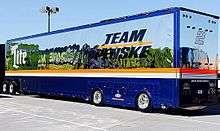
Team Penske (formerly Penske Racing) is an American professional stock car racing and open wheel racing team that currently competes in the IndyCar Series and NASCAR Sprint Cup Series, and the Xfinity Series. Debuting at the 1966 24 Hours of Daytona,[1] the team has also competed in various other types of professional racing such as Can Am, Trans Am and Formula One. Team Penske is a division of Penske Corporation, and is owned and chaired by Roger Penske. The team president is Tim Cindric.
IndyCar Series
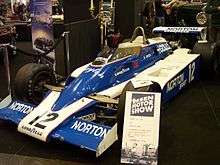
Penske has been involved with IndyCar racing since 1968, when they first fielded a stock block-powered Eagle with Mark Donohue. The team first competed at Indianapolis in 1969, and within three years had become the team to beat, winning the race with Donohue in 1972. In 1978, Roger Penske along with Pat Patrick, Dan Gurney, and several other team owners who had been participating in USAC events involving cars known as Champ Cars and IndyCars formed Championship Auto Racing Teams (CART). As of June 27, 2015, Penske Racing has won the Indianapolis 500 16 times, won the Indianapolis 500 pole position 17 times, as well as 177 open wheel IndyCar wins in USAC, CART and IRL, 29 of which are in 500-Mile Races and 13 open wheel championships. Penske Racing has 1,463 starts in IndyCar races, 231 pole positions, 71 wins from pole, 47 double wins of which 8 are 1–2–3 finishes from the Pocono race on June 26, 1977, to January 1, 2015.
In 2001, team Penske marked its return to the Indy 500 after a five-year absence due to the open wheel split, after the 1995 PPG IndyCar World Series season. Later, in 2001 Roger Penske announced he would leave CART for the IRL IndyCar Series.
Team Penske currently fields four cars: the No. 2 Verizon Dallara/Chevrolet for Juan Pablo Montoya, the No. 3 Shell Oil Company Dallara/Chevrolet driven by Hélio Castroneves, the No. 12 Verizon Wireless Dallara/Chevrolet driven by Will Power, and the No. 22 Penske Truck Rental Dallara/Chevrolet driven by Simon Pagenaud. Castroneves has won the Indianapolis 500 three times (2001, 2002 and 2009), as well as other CART and IRL races with Team Penske. Sam Hornish Jr. is the 2006 Indianapolis 500 winner and the (2001, 2002, and 2006) IndyCar Series Champion, with 16 IndyCar Wins. His 2001 and 2002 championships were with Panther Racing, prior to joining Team Penske. Juan Pablo Montoya is the 2015 Indianapolis 500 winner and the provisional leader in the championship with 2 wins in the season. The open-wheel racing portion of Penske Racing had been based in Reading, Pennsylvania since 1973 with the cars, during the Formula One and CART era, being constructed in Poole, Dorset, England as well as being the base for the F1 team.[2][3] On October 31, 2005, Penske Racing announced after the 2006 IRL season, they would consolidate IRL and NASCAR operations at the team's Mooresville North Carolina facility;[4] with the flooding in Pennsylvania in 2006, the team's operations were moved to Mooresville earlier than expected.
Late in 2005, Team Penske announced primary sponsor Marlboro, which had been a sponsor with Team Penske since the 1989 Indianapolis 500, and primary sponsor of all Team Penske IndyCars since 1991, would not appear on the cars any longer in accordance with the Tobacco Master Settlement Agreement restricting cigarette advertising by name. Since 2007, the IndyCar Series cars have carried "Team Penske" insignia and sponsorship from Mobil 1 (although the cars remained painted in the Marlboro color scheme—in Formula 1 the Scuderia Ferrari Marlboro has a similar set up). For 2009, Cellco Partnership, a joint venture of Verizon and Vodafone, joined Exxon Mobil as associate sponsors, and the team will be billed as Verizon Championship Racing. The third car was driven by Will Power, originally a substitute for Castroneves, carried the No. 12 and featured primary sponsorship of both Cellco's Verizon Wireless brand and Roger Penske's truck rental business. In 2010, Phillip Morris USA discontinued their relationship with Team Penske, ending a 19-year partnership. The team subsequently changed their livery to black and white (similar to McLaren that have black-silver livery in 1997–2005), reflecting Verizon sponsorship. Team Penske became a three-car team for the first time since 1994, with the addition of a full-time team for Power.
Roger Penske announced a switch to Chevrolet powerplants for the 2012 IndyCar Series season.[5] Once again, Penske would dominate the early portion of the season, winning 4 consecutive races, with Castroneves taking the season opener at St. Petersburg, and Power capturing wins at Barber, Long Beach, and São Paulo. Briscoe would have struggles throughout the season, but managed to find victory lane at Sonoma. However, Power would come up short in the championship after a crash at the season finale. Briscoe left the team after 2012 for other opportunities.
In 2014, Will Power took the IndyCar Championship for Team Penske after 3 concurrent runner up finishes in 2011-2013.[6]
The 2015 season started well for Team Penske, Juan Pablo Montoya won the first race of the season, his second win for Penske since he arrived from NASCAR in 2014, with teammates Will Power, Helio Castroneves and Simon Pagenaud (first season with the team) finishing 2nd, 4th and 5th. Power got a win at the Grand Prix of Indianapolis in the 5th race of the season and just 2 weeks later, the Colombian Montoya won Indy 500 leading again teammate Will Power. Juan Pablo Montoya would loose the championship in the final race on a tie-breaker to Scott Dixon.[7]
Team Penske would go on to dominate 2016, filling the top 3 positions in the final standings. Capping the season with a dominating race victory, Simon Pagenaud won his first IndyCar championship, becoming the ninth Penske driver to be crowned champion. Roger Penske’s organization claimed its 14th such title and its second in three years (Power won in ’14).[8]
1994 PPG IndyCar World Series

Penske's 1994 IndyCar World Series Championship was one of, if not the most dominating performance from a race team in history of American open wheel racing. Roger Penske had found the key to win but also found a way to run from the competition. The new Penske PC-23 chassis with the Ilmor- Indy V8 engine would power the Marlboro Team Penske drivers of Al Unser, Jr., Paul Tracy, and Emerson Fittipaldi. The team racked up 12 wins out of 16 races, collecting 10 poles and 28 podium finishes on their way to the championship. The team also dominated a controversial May at Indianapolis. Marlboro Team Penske debuted a radical new Mercedes-Benz engine at Indy, the 500I. This engine used a provision in the rules intended for stock block pushrod engines such as the V-6 Buick engines that allowed an extra 650 cm³ and 10 inches (4.9 psi/33.8 kPa) of boost. This extra power (at least 900 horsepower, and rumored to be in excess of 1000) allowed the Penskes to run significantly faster, giving them the pole and outside front row on the grid for the 78th Indianapolis 500. Al Unser, Jr. and Emerson Fittipaldi dominated the race, eventually lapping the field with 16 laps to go in the 200 lap race when Fittipaldi made contact with the wall coming out of Turn 4, giving Al Unser, Jr. the lead and win. The only driver who finished on the lead lap was rookie Jacques Villeneuve. This one season gave Marlboro Team Penske the Driver's Championship with Al Unser, Jr., Constructor's Cup with the Penske PC-23, and Manufacturer's Cup with the Ilmor-Indy V8 engine. (Ironically in the 1995 Indy 500 Penske failed to qualify any cars for the race)
Drivers who have raced for Team Penske (USAC/CART/IRL/INDYCAR)
 Mark Donohue (1968–1975)
Mark Donohue (1968–1975) David Hobbs (1971)
David Hobbs (1971) Gary Bettenhausen (1972–1974)
Gary Bettenhausen (1972–1974) Gordon Johncock (1972)
Gordon Johncock (1972) Mike Hiss (1972, 1974)
Mike Hiss (1972, 1974) Tom Sneva (1975–1978)
Tom Sneva (1975–1978) Bobby Allison (1973, 1975)
Bobby Allison (1973, 1975) Mario Andretti (1976–1980)
Mario Andretti (1976–1980) Rick Mears (1978–1992)
Rick Mears (1978–1992) Bobby Unser (1979–1981)
Bobby Unser (1979–1981) Bill Alsup (1981)
Bill Alsup (1981) Kevin Cogan (1982)
Kevin Cogan (1982) Al Unser (1983–1989)
Al Unser (1983–1989) Johnny Rutherford (1984) (injury replacement)
Johnny Rutherford (1984) (injury replacement) Mike Thackwell (1984) (injury replacement)
Mike Thackwell (1984) (injury replacement) Danny Sullivan (1985–1990)
Danny Sullivan (1985–1990) Geoff Brabham (1989) (injury replacement)
Geoff Brabham (1989) (injury replacement) Emerson Fittipaldi (1990–1996)
Emerson Fittipaldi (1990–1996) Paul Tracy (1991–1994, 1996–1997)
Paul Tracy (1991–1994, 1996–1997) Al Unser, Jr. (1994–1999)
Al Unser, Jr. (1994–1999) Jan Magnussen (1996) (injury replacement)
Jan Magnussen (1996) (injury replacement) André Ribeiro (1998)
André Ribeiro (1998) Alex Barron (1999, 2003; 2003 as injury replacement)
Alex Barron (1999, 2003; 2003 as injury replacement) Gonzalo Rodriguez (1999) (killed at Laguna Seca Raceway)
Gonzalo Rodriguez (1999) (killed at Laguna Seca Raceway) Tarso Marques (1999) (injury replacement)
Tarso Marques (1999) (injury replacement) Gil de Ferran (2000–2003)
Gil de Ferran (2000–2003) Hélio Castroneves (2000–present)
Hélio Castroneves (2000–present) Max Papis (2002) (injury replacement)
Max Papis (2002) (injury replacement) Sam Hornish, Jr. (2004–2007)
Sam Hornish, Jr. (2004–2007) Ryan Briscoe (2008–2012)
Ryan Briscoe (2008–2012) Will Power (2009–present) (legal replacement, 1 race; two other races in No. 12 in 2009, full-time in 2010 beyond)
Will Power (2009–present) (legal replacement, 1 race; two other races in No. 12 in 2009, full-time in 2010 beyond) A. J. Allmendinger (2013)
A. J. Allmendinger (2013) Juan Pablo Montoya (2014–present)
Juan Pablo Montoya (2014–present) Simon Pagenaud (2015–present)
Simon Pagenaud (2015–present) Oriol Servia (2016) injury interim)
Oriol Servia (2016) injury interim) Josef Newgarden (2017–present)
Josef Newgarden (2017–present)- Note: This does not include Greg Moore, who in mid-1999 signed a contract with Penske Racing to join the team for the 2000 season. Moore was killed in a crash on Lap 10 of the Marlboro 500 at the Auto Club Speedway in the last race of the 1999 season while in his last race for Forsythe Championship Racing. Castroneves, who had been driving for Hogan Racing, which shut down after the 1999 season, was tapped to fill that seat.
NASCAR
Sprint Cup Series
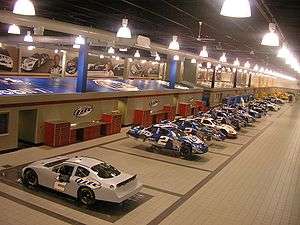
Formerly known as Penske Racing, Kranefuss-Penske Racing, Penske Racing South, Penske-Jasper Racing, Penske Championship Racing, and now simply known as Team Penske to conform with Penske's other teams, Penske's NASCAR team made its debut in 1972 at Riverside International Raceway. Mark Donohue was driving a factory-sponsored red-white-blue American Motors Matador. It was dubbed the "flying brick" by many noting its squarish aerodynamics. The car finished 39th after rear end problems. The team ran part-time for a few years, fielding cars for several drivers including Donohue, Dave Marcis, Donnie Allison, and Bobby Allison. The team went full-time with Bobby Allison in 1976 with a new, more aerodynamic fastback coupe, finishing 4th in the points. In 1980, the team fielded two races for Rusty Wallace, finishing 2nd in his first race at Atlanta. Penske sold his machinery to the Elliott family in 1977 and got out of NASCAR.[9]
The team did not run for eleven years, returning in 1991 with Wallace at the wheel again, with Rusty moving his Miller beer dollars to the new team from the recently suspended operations of Raymond Beatle's Blue Max Racing team. Early in 2008, Roger Penske and Penske Racing won the 2008 Daytona 500 with Ryan Newman, the first time Penske has won a restrictor plate race, winning with a 1–2 finish.
In 2003, Penske switched from fielding Fords to Dodges. By 2011, however, Penske was the only NASCAR team running Dodges full-time as most of the former Dodge teams had either folded or switched to other brands such as Chevrolet, Ford or Toyota. Owner Roger Penske announced on March 1, 2012 that the team would return to Ford in 2013.[10]
In 2012, with Dodge, Brad Keselowski gave Penske his first Sprint Cup title.
For the 2016 season Penske Racing South fielded the No. 2 Miller Lite Ford Fusion for Keselowski and the No. 22 Shell/Pennzoil Ford Fusion for Joey Logano. The team also supplies cars to the historic NASCAR team, Wood Brothers Racing, who fields Penske development driver Ryan Blaney on a full-time basis.
In 2014, the team changed their name branding from "Penske Racing" to "Team Penske" to match their IndyCar name.[11]
Car No. 02 history
Penske's No. 02 team originally began running in the ARCA RE/MAX Series in 2000 as the No. 27 Ford sponsored by Alltel and driven by Ryan Newman.[12] Later in the year, the team made its Winston Cup debut with Newman at Phoenix as the No. 02 Alltel Ford, finishing 41st due to engine failure. In 2001, Newman split time between ARCA, the NASCAR Busch Series, and the NASCAR Winston Cup Series.[13][14] He drove in 15 Busch races and won at Michigan. In the Cup Series, he participated in seven events, and almost won The Winston Open before his engine expired in the closing laps. He put together two top-five finishes, which included a second-place finish at Kansas, and a pole in his abbreviated schedule.
Car No. 06 history

In 2004, Penske occasionally ran a fourth car numbered 06, sponsored by Mobil 1. Craftsman Truck Series driver Travis Kvapil attempted four races, failing to qualify at Darlington, with a best finish of 21st at Martinsville. He would replace Brendan Gaughan in the 77 in 2005. Chad Blount also ran the car at Talladega, finishing 41st.
The No. 06 returned in 2007 with Sam Hornish, Jr. in preparation for moving full-time in the 77 the next year. The No. 06 was again sponsored by Mobil 1. Hornish, Jr. attempted eight races, but only qualified for the final two races of the season, with a best finish of 30th at Phoenix.
Car No. 2 history
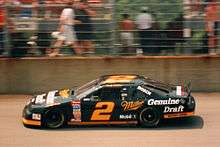

The No. 2 team has not seen many changes since its debut in the 1991 Daytona 500, where it finished 27th after a crash late in the race. 1989 Winston Cup Champion Rusty Wallace drove the car from 1991 to 2005, with some form of Miller Beer as the primary sponsor of the No. 2. Wallace moved to Penske from Blue Max Racing, which suspended operations after 1990. The team performed impressively in its first year, winning two races and finishing 10th in points. 1992 was decent for Wallace, as he won one race and finished 13th in points. Things then turned around for the him and Penske, winning 25 races over the next four years, despite never winning the championship.
The team switched from Pontiac to Ford in 1994.[15] The season finale at Atlanta Motor Speedway and the entire 1996 season saw a small change when the popular Miller Genuine Draft paint scheme was replaced with a red, blue and yellow splashed scheme that advertised the Miller brand. After winning five races that season, Wallace donned the blue and white colors of Miller Lite in 1997. After winning one race a piece over the next three years, he put together four wins and won nine Bud poles in 2000, the highest total of his career. 2002 was a disappointment however, as he failed to win races, marking the first year since 1985 that he did not score a win. After that year, the team switched manufacturers from Ford to Dodge. In 2004, Wallace announced the 2005 season would be his last in the Nextel Cup Series, citing his son's racing career and wanting to concentrate on his Busch Series team, Rusty Wallace Racing, for the departure. During that season Wallace returned to victory lane for the first time since 2001 at Martinsville, one of his historically strong racetracks. Although he wouldn't win a race during his final season, Wallace qualified for the Chase for the Nextel Cup and finished eighth in series points.
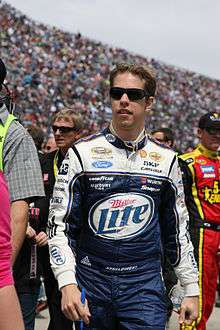
In order to replace the retiring Wallace, Penske tabbed 2004 Nexel Cup Champion Kurt Busch. However, this caused a problem with Busch's then-current team, Roush Racing, as he was still under contract for the 2006 season. The situation was resolved thanks in part to the resolution of another disputed contract with Roush. Roush Racing signed Jamie McMurray to drive their No. 6 car for the 2006 season but his previous team owner, Chip Ganassi, would not let him drive for Roush. Eventually, an agreement was struck where McMurray was released from his team to replace Busch in the No. 97 car (which was then renumbered to 26), therefore freeing up Busch to drive the No. 2 car. He quickly brought the team back to victory lane by winning in his fifth start with the team at Bristol, his only win of 2006. The No. 2 team finished 16th in the season points. Busch won six additional races with the No. 2 car, his last being the 2010 Coca-Cola 600. He qualified for the Chase three times, with a best finish of fourth in the final standings.
Brad Keselowski and the No. 12 team moved over to the No. 2 team for the 2011, with Nationwide Series crew chief Paul Wolfe replacing Jay Guy. The No. 2 team with Keselowski and Wolfe initially struggled for the first half of the season; however, they did win a fuel-milage race at Kansas. In an ironic twist, the team's performance started to improve dramatically after Keselowski injured his leg during a testing crash at Road Atlanta. He and Wolfe grabbed two more wins at Pocono and at Bristol and rallied to make the 2011 Chase field. However, the final 10 races would be an up and down affair for the team, and they were knocked out of contention after finishing 18th at Phoenix. Nonetheless, Keselowski managed a fifth-place finish in points, a dramatic turnaround from his 2010 performance.
2012 would be better still for the team, as Keselowski won five races at Bristol, Talladega, Kentucky, Chicagoland, and Dover, with the last two being his first Chase wins. He would ultimately win Team Penske its first Sprint Cup title after a close battle with Jimmie Johnson.
2013 was a step back, as Keselowski opened the season with four top fives but struggled with consistency from there and eventually missed the Chase altogether. He would win a single race, at Charlotte in October, and rallied to finish fourteenth in points, the highest rank outside the Chase field (due to the Richmond scandal that resulted in Jeff Gordon getting an additional Chase berth).
Keselowski recovered quickly in 2014, winning the third race of the year at Las Vegas after Dale Earnhardt, Jr. ran out of gas on the final lap. He later dominated and won Kentucky to become the first two-time winner at the track, and dominated the July race at Loudon and the September race at Richmond as well, to secure the top seed in the reformatted Chase for the Sprint Cup. Keselowski then won back to back for the first time in his career in the first Chase race at Chicagoland, to secure an immediate transfer into the Contender round of the new Chase. After suffering a blown tire at Kansas and tussling with Matt Kenseth and Denny Hamlin at Charlotte, Keselowski went to Talladega needing to win to make the Eliminator round, which he ultimately did after outbattling Ryan Newman on the final lap. However, he suffered a mechanical failure that caused him to wreck at Martinsville, and subsequently tangled with Jeff Gordon at Texas, which led to a post-race brawl that became one of the highlights of the season. Keselowski would ultimately be eliminated from the Chase after Phoenix, and finished fifth in the final points, with his six wins being a career high.
Keselowski won his first race of 2015 at Auto Club Speedway after taking advantage of two late cautions to run down the dominant car of ex-teammate Kurt Busch. This would prove to be the only win of his season, but Keselowski was once again able to advance to the Eliminator round of the Chase before suffering another wreck at Martinsville, and after leading the majority of the Texas race only to be passed by Jimmie Johnson with six laps to go, Keselowski was once again eliminated from championship contention after Phoenix.
Keselowski got back to his winning ways again in 2016, breaking through at Las Vegas for the second time in three seasons. He also scored his third win in the GEICO 500 at Talladega, then found his first Daytona win in the Coke Zero 400, followed by his third career win at Kentucky.
Car No. 12 history
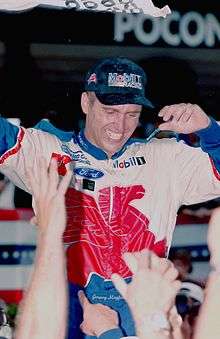
The current 12 car started out in 1994 at Michigan as the No. 07 Ford driven by Robby Gordon and owned by German-American businessman and former Ford executive Michael Kranefuss along with Newman/Haas Racing co-principal Carl Haas. The car started and finished 38th after Gordon crashed on lap 70. After another start with Geoff Brabham at the Brickyard 400, the team— known as Kranefuss-Haas Racing— went full-time in 1995 with John Andretti driving the Kmart/Little Caesars-sponsored No. 37 Ford. Andretti won the pole at the Mountain Dew Southern 500 and finished 18th in the points. The team struggled in 1996 and Kranefuss decided to replace Andretti with Jeremy Mayfield in what amounted to a driver swap between Kranefuss-Haas and Cale Yarborough's team as Andretti replaced Mayfield in Yarborough's No. 98. The team picked up co-sponsorship from Royal Crown Cola for the following season and improved to be 13th in the points in 1997, but it was obvious the team wouldn't succeed if it only fielded one team. At the end of the season Kranefuss and Haas dissolved the partnership and the Kmart sponsorship moved over to Travis Carter's team, which became Haas-Carter Motorsports.
In 1998, Kranefuss and Penske Racing announced a merger, with Mayfield coming aboard to drive the No. 12 Mobil 1-sponsored Ford Taurus as a teammate to Rusty Wallace. The move turned out to be a success, and Mayfield became the next big star. He won the pole at Texas, and at one point in the season, found himself in the points lead. At the Pocono 500 in June, he won his first Winston Cup series race. Mayfield's breakout year in Winston Cup ended with a 7th-place finish in the points. Mayfield struggled in 1999, as he did not win and dropped 4 spots in the points. In 2000, he won the Pocono 500 and California 500. Midway through the season, Kranefuss sold his share of the team to Penske. Mayfield then suffered a concussion while practicing for the Brickyard 400. He missed two races recuperating from his injury and finished 24th in points. In 2001, Mayfield posted seven top-10 finishes, but was fired following the race at Kansas. Rusty Wallace's younger brother Mike Wallace took over, and came close to winning at Phoenix before settling for second place to Jeff Burton.
Ryan Newman and his Alltel Wireless team took over the No. 12 car in 2002, although Mobil 1 stayed on as primary sponsor for several races per season. In his rookie year Newman waged a spirited battle with Jimmie Johnson for NASCAR Rookie of the Year honors. Newman won The Winston, and the fall event at New Hampshire, as well as six poles. Although he didn't win as many races as Johnson (one versus Johnson's three) and finished behind him in the points (sixth place, seven points behind fifth-place Johnson), he finished ahead of Johnson to win Winston Cup Rookie of the Year. After the switch to Dodge in 2003, he won eight races and eleven poles, and finished 6th in points.
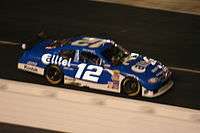
In 2004, Newman won twice, earned nine pole positions, qualified for the inaugural Chase for the Nextel Cup, and finished seventh in points. Newman finished 2005 with eight pole positions, but only one win. He qualified for the Chase for the Cup for a second year in a row and ended up sixth in the final standings. He failed to win a race and missed the Chase in both 2006 and 2007. However, he found himself back in the winners circle early in 2008, taking victory in the 50th running of the Daytona 500 (the No. 2 of Kurt Busch finished second) to open the season, claiming Penske's first Daytona 500 win. After the No. 12 team won the Daytona 500 in 2008, it struggled and Ryan Newman announced during the summer that he would leave to drive the No. 39 Chevrolet for Stewart-Haas Racing.
The No. 12 car lost its sponsor in 2009 as Cellco Partners, a joint venture of Verizon and Vodafone, closed the deal to purchase Alltel in January 2009, thus voiding the terms of the grandfather clause that allowed the No. 12 car to run with a sponsor that is a direct competitor to that NASCAR series' sponsor. The team announced that they would move the Wireless sponsorship to the IndyCar Series and the NASCAR Nationwide Series and renamed the team to Verizon Championship Racing, a reference to Verizon Wireless' Penske-wide marketing through both its IndyCar and NASCAR sponsorships, complete with its heritage of champions (especially on Vodafone's side, as it was a sponsor of Scuderia Ferrari). Penske hired David Stremme to race the car in a largely unbranded fashion for 2009, but he did not produce results and was fired toward the end of the season. Brad Keselowski, who had recently signed with Penske when he was unable to procure a seat at Hendrick Motorsports, took over the car toward the end of the 2009 season. He then ran the No. 12 full-time in 2010 again in an unbranded fashion, although FloTV and AAA sponsored several races. Keselowski moved to the No. 2 car following the season to replace Kurt Busch, who moved to the new No. 22.
The No. 12 did not run any races in 2011. In 2012, Sam Hornish, Jr. drove the No. 12 at Kansas in April with an SKF sponsorship. The No. 12 was also scheduled to run at the October Talladega race with Hornish, but after the termination of A. J. Allmendinger from the No. 22, Hornish replaced him full-time. Hornish's SKF sponsorship was transferred to the No. 22 for this race.
In 2013, Hornish again qualified at Kansas, but crashed out of the race in a multi-car wreck. He attempted the fall Talladega race, but failed to make the race after qualifying was rained out.[16]
With Hornish leaving for Joe Gibbs Racing, the part-time No. 12 was split by various Penske drivers in 2014. SKF sponsored three races, with Ryan Blaney at Kansas in April and Talladega in October, and Juan Pablo Montoya at Michigan in June. Montoya also drove the No. 12 in the Brickyard 400 with sponorship from Penske Truck Rental.[17]
Car No. 22 history
After the 2010 season, Shell and Pennzoil came over to Penske and sponsored the new No. 22 Cup car in 2011 with Kurt Busch (who had previously driven the team's No. 2). The No. 22 shared the Shell sponsorship with Penske's IndyCar driver Helio Castroneves. The team won two races at Sonoma and Dover and made the Chase, but poor finishes during the Chase left Busch 11th in points. Busch and Penske Racing agreed to mutually part December 5, 2011.[18] though some leading to speculation that he was fired.
On December 21, 2011, A. J. Allmendinger was announced as the driver for the 2012 season, moving over from Richard Petty Motorsports. He would team up with newly promoted crew chief Todd Gordon after the departure of Steve Addington to Stewart-Haas Racing.[19] Allmendinger got off to a slow start to the season, but took advantage of a late wreck among the leaders to finish second at Martinsville. After he failed a drug test before the July Daytona race, he was removed from the car. Penske Nationwide series driver Sam Hornish, Jr. was named as replacement for the remainder of the season.[20] Hornish had previously driven for Penske in Cup from 2008–2010. Hornish challenged for a win at Watkins Glen, and ended up finishing fifth. After failing to record another top-10 finish, Penske removed him from the car at season's end.
On September 4, 2012, Joey Logano was announced as Hornish's replacement in the No. 22 car in 2013.[21] Logano became the fourth driver of the No. 22 in three years, but had a successful 2013 season, making the Chase, and returned in 2014, becoming the first driver to return to the No. 22 car for more than a single season. Logano won five races in 2014, two more than in his entire previous career, and made the Championship round of the revamped Chase, only to suffer pit road miscues at Homestead that relegated him to fourth in the standings.
Logano then began the 2015 season by winning the Daytona 500. He then won five further races, including repeat wins in the Bristol Night Race and the Kansas Chase race, part of a streak of three wins in a row that allowed him to sweep the Contender round of the 2015 Chase. However, a feud with Matt Kenseth derailed Logano's season when Kenseth wrecked him out of the lead at Martinsville; heavy damage from a blown tire the next week at Texas and his failure to win at Phoenix resulted in Logano's elmination from the Chase.
Car No. 77 history
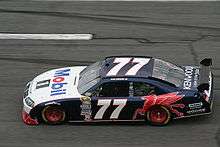
The No. 77 car began running in 2004 after Penske merged with Jasper Motorsports. Brendan Gaughan was hired as the driver, with Kodak sponsoring. Gaughan had four top-ten finishes and finished 28th in points in his rookie year. Gaughan was fired for lack of performance at the end of the season.
Gaughan was immediately replaced by Travis Kvapil in 2005. Kodak continued to sponsor the team, though Mobil 1 came on to sponsor one race. Kvapil had two top-tens and finished 33rd in points. The No. 77 team shut down for the next two years due to a lack of sponsorship.
In late 2007, Penske Racing announced that the No. 77 team would return to racing with Mobil 1 as a sponsor and that Sam Hornish, Jr., one of Penske's IndyCar series drivers, would switch to NASCAR full-time and drive the car in 2008.
The team underwent a points swap with Kurt Busch's No. 2 car to guarantee Hornish a spot in the first five races while allowing Busch to qualify automatically if necessary with his Past Champion's Provisional starts.
The team did the same in 2009 as Bill Davis (formerly of Bill Davis Racing) sold the owner points from his No. 22 Toyota to Penske, which guaranteed Hornish a spot in the first five races of the season. Hornish's performance improved enough in this year that the No. 77 ended the year in the top 35 in owner points. With the departure of Mobil 1 to Stewart Haas Racing for the 2011 season, the No. 77's operations were consolidated with those of the No. 2 and Hornish was removed from Penske's Cup Series roster.
Xfinity Series
Penske's first entry in the now Xfinity Series was in 1997, with Cup driver Rusty Wallace at Auto Club Speedway. Wallace started 37th and finished 21st in his Miller Lite Ford.
Car No. 02 / 39 / 48 history
Penske Racing's next foray into the Busch Series was in 2001. Ryan Newman drove 15 races in the 02 Alltel Ford in preparation for moving up to the Winston Cup Series the next year. "Rocket Man" Newman had 6 poles and only two starts outside the top 5. Newman had 8 top 10's including a win at Michigan International Speedway, and would finish 28th in points despite running less than half the season.
In 2005, Penske returned to the second-tier series with Ryan Newman. Newman drove an Alltel/Mobil 1/Sony Dodge numbered 39, his sprint car number whose digits coincidentally add up to the number 12 he used in the Cup Series. He ran only 9 of 25 races, but had four poles and six victories. In 2006, Newman and Kurt Busch shared the ride. Busch ran seven races and won twice; Newman's best finish was 2nd in six starts. IndyCar Champion Sam Hornish, Jr. began racing the No. 39 in the last two races of the year, crashing out of both races. Newman also ran a 02 car at Watkins Glen, finishing 41st after an engine failure.
The only race for the 39 in 2007 was at Watkins Glen International, where Kurt Busch started on the pole and finished 3rd.
In 2013, Penske ran a third team part-time, numbered 48. Joey Logano ran the car at Watkins Glen with Discount Tire as the sponsor,[22] starting 3rd and finishing 21st. Ryan Blaney then ran the car at Phoenix with AutoZone, finishing 10th.[23] Brad Keselowski ran the car at Homestead with Discount Tire, winning the race.[24]
Car No. 12 history
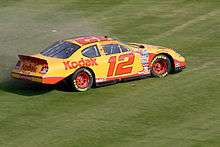
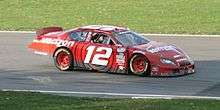
The 12 car debuted in 2007, running 20 total races. Kurt Busch ran 3 races with Penske Truck Rental, with a best finish of 4th at Las Vegas. Sam Hornish Jr. ran 9 races but had no top 10's and four crashes. Ryan Newman ran 8 races with Kodak and Alltel, with a best finish of 3rd at Richmond.
The team returned return on limited basis in 2008, with Hornish driving most of the races early in the season. Hornish attempted 10 races (failing to qualify for two) with fewer DNFs and a best finish of 11th at Darlington. ARCA Champion Justin Allgaier ran four races later in the year, with an 11th-place finish at Phoenix.
In 2009, Justin Allgaier moved into the car full-time. After Verizon, taking on the sponsorship responsibilities of Alltel, was barred from sponsoring the No. 12 Cup car under terms of the Viceroy Rule – preventing competition with title sponsor Sprint NEXTEL – the company moved their sponsorship to the Nationwide Series.[25] Allgaier was involved in a close rookie battle with Michael McDowell and Scott Lagasse Jr., but eventually won the 2009 Rookie of the Year, scoring 12 top 10s en route to a 6th-place points finish. Allgaier and Verizon returned for 2010. Justin took his first career victory in the fourth race of the season at Bristol Motor Speedway. The team had an impressive 20 top 10s and finished 4th in points.

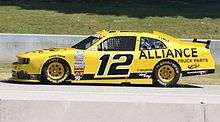
Due to Verizon's departure from NASCAR for Penske's IndyCar team, the No. 12 team scaled back to a limited schedule in 2011, prompting Allgaier to move to Turner Motorsports. Sam Hornish Jr., recently losing his Cup ride with Penske, took over the car on a limited basis with Alliance Truck Parts sponsoring his effort. Hornish won his first Nationwide Series race at Phoenix, a track where he had had success in IndyCar. Alex Tagliani drove the No. 12 in Montreal with sponsorship from Hot Wheels.
Hornish returned for the full season in 2012, with expanded sponsorship from Alliance. Hornish had arguably his strongest season in stock cars to date after struggles in past Sprint Cup and Nationwide endeavors, scoring 10 top 5's and 22 top 10's en rout to a fourth-place points finish.
Hornish returned to the car in 2013, and scored his second NASCAR victory at Las Vegas. He was a strong contender for the drivers' title, earning 4 poles, 16 top 5's and 25 top 10's, but ultimately finished second to Austin Dillon in the final points standings, despite Dillon not winning a race. Hornish was left without a full-time ride, as longtime owner Roger Penske did not have any opportunities for his former champion, though he did say Hornish deserved another opportunity at NASCAR's top level.[26] Sponsors Alliance Truck Parts, WURTH, and Detroit Genuine Parts would move up to sponsor Brad Keselowski's Sprint Cup car in 2014.[27]
In 2014, after Hornish left for Joe Gibbs Racing, Team Penske narrowed down their Nationwide Series fleet to one full-time ride – the No. 22 team –leaving the No. 12 as a part-time ride. Ryan Blaney ran four races in the car, with Joey Logano running a single race at Watkins Glen, with sponsorship from Snap-on Tools and Western Star Trucks. Logano would win the pole with a new track record, and go on to win the race.
In 2016, Ryan Blaney drove the No. 12 in May at Charlotte and again in July at Kentucky. Joey Logano then drove the No. 12 at Watkins Glen in August and again at Charlotte in October, winning both races. Snap-On Tools was the primary sponsor for all the races except the October Charlotte race, where PPG Industries was the primary sponsor.
On August 12, 2016, Team Penske announced that the No. 12 team will be a full-time team in 2017, with driver and sponsorship to be announced.
Car No. 22 history
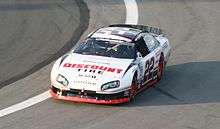
In 2009, Penske developmental driver Parker Kligerman made his debut at Kansas Speedway, winning the pole, leading 7 laps, and finishing a respectable 16th. Parker also attempted the season finale at Homestead, but failed to qualify, running the No. 42 car instead.
For 2010, Penske Racing ran two full-time Nationwide series cars with Discount Tire and Ruby Tuesday coming on board to sponsor Brad Keselowski in the No. 22. They continued to use Dodge engines, despite Dodge cutting their Nationwide support. On November 6, 2010, Brad Keselowski and the No. 22 Discount Tire/Ruby Tuesday Nationwide team secured the NASCAR Nationwide driver championship by finishing 3rd at Texas Motor Speedway. By holding an insurmountable 465-point lead over Carl Edwards with two races left in the season, the No. 22 team delivered Roger Penske's first NASCAR title of any kind.
For the 2011 season, Penske continued to run the No. 22 full-time with Brad Keselowski. In August, Keselowski suffered a hard crash while testing at Road Atlanta. He was replaced in the No. 22 by Hornish Jr., Kurt Busch, and Parker Kligerman. Formula 1 Champion Jacques Villeneuve drove the No. 22 at the road courses. The No. 22 team scored five wins with Keselowski and another with Busch at Watkins Glen.
In 2012, Keselowski was scheduled to split the 22 ride, with Parker Kligerman running between 5 and 7 races. However, after only running three races with the team, Kligerman was replaced in both the Nationwide Series and his Camping World Truck Series ride at BKR with fellow up-and-coming driver Ryan Blaney, who ran the standalone oval races.[28] Villeneuve was named to drive at Road America and Montreal for the team.[29]
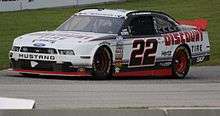
In 2013, Brad Keselowski and Ryan Blaney were scheduled to share the No. 22, joined by new Penske driver Joey Logano. In June, former Penske Cup driver A. J. Allmendinger signed on to run two races in the 22, at the road courses Road America and Mid-Ohio.[30] Allmendinger won the pole at Road America,[31] then proceeded to win the race, his first career Nationwide win, after leading 29 laps.[32] Allmendinger then won at Mid-Ohio after starting second and leading 73 of 94 laps.[33] Ryan Blaney then won his first career race at Kentucky Speedway, after leading 96 of the final 100 laps of the race.[34] The team won the Nationwide Owners' Championship on the strength of twelve total race victories among the four drivers. This was the first Nationwide Owners title for Team Penske.[24]
In 2014, the No. 22 car was shared by Joey Logano, Brad Keselowski, Ryan Blaney, and Alex Tagliani in hopes of defending the Nationwide Owners' Championship. Michael McDowell ran the car at Kentucky in September, the 5th driver to run the car in 2014.[35] The No. 22 team beat the No. 54 JGR team once again for the owner's title. They again beat the #54 team for the owners title in 2015, before going winless in 2016.
The No. 22 team is known for its competition for the Nationwide Owner's Championship with the equally strong Joe Gibbs Racing and their No. 18 and No. 20 teams.
Car No. 26 history
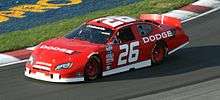
In an alliance with K-Automotive Racing (owned by Brad Keselowski's brother Brian), Penske fielded the 26 car in select races in 2010, primarily Car of Tomorrow races. Nineteen-year-old Parker Kligerman debuted in the car at Daytona with Discount Tire, starting on the outside pole and finishing 13th.[36] His next race was Montreal, where he scored a strong 8th-place finish. He then finished 15th at Richmond. At Charlotte in October, Parker qualified 8th, but crashed after only 3 laps and finished last.[37] Sam Hornish Jr. ran the season finale in the 26, finishing 21st.
Trans-Am Series
Penske first fielded a Blue Sunoco 1967 Camaro driven by Mark Donohue in this series designed for Pony cars like the Ford Mustang. Penske entered Camaros won the series championship in 1968 and 1969. Later they [38] switched to a red/white/blue American Motors backed 1970 AMC Javelin, and later the restyled 1971 AMC Javelin AMX which had an aerodynamic tail spoiler and other features suggested by Donohue. The Javelin took the series championship in 1971, 1972 and 1976. Alongside the Camaros.
Can-Am Series
Penske Racing entered a Lola T70 in the 1966 Can-Am Series for Mark Donohue, resulting in one win at Mosport. In 1967, Penske Racing entered two Lolas, one for Mark Donohue and one for George Follmer. 1968 saw Penske switch to a McLaren M6, which had won the series in 1967. Donohue won one race that year in Can-Am at Bridgehampton. With the McLaren domination of the Can-Am, Penske switched back to Lola Cars for his 1969 Can-Am efforts, but only entered the car in one race at Mid-Ohio.
From 1972 to 1974, Penske was Porsche's official partner in the CanAm Series. In late 1971, Penske and Mark Donohue helped to develop the tubocharged version of the Porsche 917. George Follmer won the series in 1972, and Donohue dominated CanAm in 1973 with the ultimate evolution of the 917, the 917/30. The rules were changed for 1974, and Penske raced only once this year.
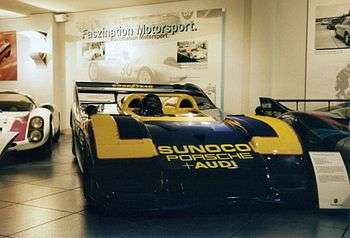
Endurance racing
A Lola T70 Mk IIIb entered by Penske was the surprise winner of the 1969 24 Hours of Daytona.
During the 1970 season the competition between the 5-liter sportscars of Porsche and Ferrari turned to the advantage of the Porsche 917. In 1971, Ferrari decided to give up any official effort with the 5-liter Ferrari 512. In order to prepare the 1972 season, the new works prototype Ferrari 312PB was presented and engaged by the factory in several races.
Roger Penske bought a used 512 M chassis that was totally dismantled and rebuilt. The car was specially tuned for long races receiving many unique features, among them were a large rear wing and an aviation inspired quick refueling system. The engine was tuned by CanAm V8 specialist Traco, and was probably able to deliver more than 600 hp (450 kW). As of today it's unknown to what extent Penske's initiative was backed by Ferrari works. This 512M was painted in a blue and yellow livery and was sponsored by Sunoco and the Californian Ferrari dealer Kirk F. White. The car made the pole position for the 1971 24 Hours of Daytona and finished second despite an accident. For the 12 Hours of Sebring the "Sunoco" made the pole again but finished the race at the sixth position after making contact with Pedro Rodrigez's 917. Despite this misfortune the car had proved to be a serious opponent for the 917. Not only this car was the fastest on track in Daytona and Sebring but it was also the car that had the shortest refueling time.
The presence of the 512 M "Sunoco" forced Porsche to pursue his effort of research and development on the 917: The 917K short tail was modified, and the 917 LH aerodynamics received further improvements. New Magnesium chassis were developed. An entirely new car, the 917/20 was built as test-bed for future CanAm parts and aerodynamic "low-drag" concepts.
In Le Mans the "Sunoco" Ferrari was unable to break the 200 mph (320 km/h) barrier on the straight while the Porsche 917 LH were lightning quick at speeds of over 240 mph (380 km/h). Mark Donohue qualified fourth anyway, which was obviously the result of an aerodynamic configuration that favored downforce over drag, which helped in the twistier sections. The car did not have much luck in the race though.
American Le Mans Series
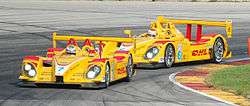
In April 2005, it was announced that Porsche would build an Automobile Club de l'Ouest (ACO) sanctioned LMP2 Class Prototype that would be entered by Penske Racing in the American Le Mans Series. The Porsche RS Spyder made its successful debut at the ALMS season final race at Mazda Raceway Laguna Seca. The "Porsche Junioren" factory drivers Sascha Maassen and Lucas Luhr finished 1st in LMP2 Class and 5th Overall in the 4–Hour Endurance Race. The livery of Penske Racing American Le Mans Series team was inspired by Jordan EJ12's DHL Formula 1 livery driven by Giancarlo Fisichella and Takuma Sato.
In 2006, Penske Motorsports fielded two LMP2 Porsche RS Spyder in the American Le Mans Series, but did not run the 2006 24 Hours of Le Mans in June. The Penske cars combined to win seven class victories and the overall win at Mid-Ohio. Penske Racing won the LMP2 team championship. Drivers Sascha Maassen and Lucas Luhr tied for first place in the driver's championship, while Timo Bernhard finished fifth, Romain Dumas finished sixth, and Emmanuel Collard finished tenth.
2006 team lineup:
- LMP2 Porsche RS Spyder No. 6: Sascha Maassen, Lucas Luhr (with Emmanuel Collard for endurance events)
- LMP2 Porsche RS Spyder No. 7: Timo Bernhard, Romain Dumas (with Patrick Long for endurance events)
In 2007, Penske Motorsports fielded two LMP2 Porsche RS Spyder Evo in the American Le Mans Series. Penske Motorsports for the 2nd year in a row did not compete in 2007 24 Hours of Le Mans in June. Penske's two cars combined for eleven class victories and eight overall victories during the twelve race season. Penske won the LMP2 team championship, and team drivers Romain Dumas and Timo Bernhard finished tied for first in the LMP2 driver's championship, while Sascha Maassen and Ryan Briscoe tied for third place.
2007 team lineup:
- LMP2 Porsche RS Spyder No. 6: Sascha Maassen, Ryan Briscoe (with Emmanuel Collard for endurance events)
- LMP2 Porsche RS Spyder No. 7: Timo Bernhard, Romain Dumas (with Hélio Castroneves (Sebring only) and Patrick Long (Road Atlanta only) for endurance events)
Penske started out their 2008 season with an overall win in the 12 Hours of Sebring. This was Porsche's first overall win in the race since 1988 in a Porsche 962.
2008 team lineup:
- LMP2 Porsche RS Spyder No. 5: Hélio Castroneves, Ryan Briscoe (Road Atlanta and Laguna Seca only)
- LMP2 Porsche RS Spyder No. 6: Sascha Maassen, Patrick Long
- LMP2 Porsche RS Spyder No. 7: Timo Bernhard, Romain Dumas (with Emmanuel Collard for endurance events)
In 2009, the No. 6 and No. 7 ALMS teams were used for Penske's No. 12 Indycar, driven by Will Power in five races. The team announced in late 2009 that the ALMS teams would be dissolved and turned into the new No. 12 Verizon sponsored Indycar for Will Power to run full-time in 2010.
Formula One
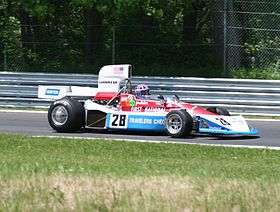
Penske entered the Formula One World Championship from 1974 to 1976. Although the cars were built at the British base in Poole, the team held an American licence.[39] In 1971, Penske had sponsored the second McLaren entry in the 1971 Canadian and US GP, entering Mark Donohue, who took the car to a podium finish. The team returned three years later, in the 1974 Canadian GP, with their own chassis, the PC1, a standard tub built around a Cosworth DFV engine and a Hewland gearbox. Donohue took the car to 12th place on its debut. In 1975, Roger Penske mounted a full season attack with the PC1, Donohue managing to score a fifth place in the Swedish GP. However, the car was retired after the French GP and Penske entered a March 751 for the next three races, scoring another fifth in the British GP. However, Donohue crashed the car in the final practice session of the 1975 Austrian Grand Prix at Zeltweg and later died from his injuries. Penske missed the Italian race, returning only for the US GP, abandoning the March 751 in favor of the PC1 with Northern Irish driver John Watson.
For 1976, Penske signed a sponsorship deal with Citibank and entered a brand new PC3 for Watson. In spite of a fifth place scored at the South African Grand Prix at Kyalami, the PC3 was evolved into the PC4, which was much more competitive, allowing Watson to score two podiums in France and Britain. Then, in the Austrian Grand Prix, the team scored their only F1 win, "forcing" John Watson to shave his trademark beard. So far this has been the last time an American constructor won a F1 race. Still, Roger Penske was tired of Europe and at the end of the year decided to concentrate solely on Indycar racing, selling the remains of his European operations to Günther Schmidt of Germany. As of the end of the 2015 Formula One season, Penske remains the last team to win a Formula One Grand Prix using an American licence.
For 1977, the car was entered by Schmidt's ATS Wheels business and run under the name of ATS Racing Team. The ATS-Penske PC4, now painted yellow, debuted in the 1977 United States Grand Prix West with Jean-Pierre Jarier at the wheel, where the Frenchman scored the team's single point of the season. A second PC4 was eventually entered for Hans Heyer and Hans Binder but the team's fortunes sunk and Schmidt quit after the Italian GP, before returning in 1978 with his own chassis. A third PC4 was built by Penske for Interscope Racing, who entered the car in the United States and Canadian Grands Prix, driven by American Danny Ongais with no results.
In 1979 Penske designed and built the HR100 for wealthy Mexican 'gentleman driver' Héctor Rebaque. The car was entered for the final three races of the season, but either failed to qualify or to finish in each case.
Supercars Championship
In 2015, Team Penske entered the Australian V8 Supercars Championship, having purchased a 51% stake in Dick Johnson Racing in September 2014. The team is known as DJR Team Penske.[40] The team raced a single Ford Falcon FG X in 2015, initially with Marcos Ambrose driving car No. 17[41] and Scott Pye as a co-driver in the Endurance Cup. Following the Australian Grand Prix support race, Ambrose requested to step aside from driving to let Scott Pye become the main driver from Round 2 at Symmons Plains onwards. Ambrose then became the endurance co-driver in the Endurance Cup.[42]
In October 2015, DJR Team Penske announced a return to a two-car team in 2016 with Fabian Coulthard to drive car No. 12 and Scott Pye in car No. 17.[43] Roger Penske later confirmed that Ambrose elected not to continue as a co-driver in 2016.[44]
Indianapolis 500 statistics
Penske Racing has the most Indianapolis 500 victories of any team in auto-racing history with 16 victories. In 1972, Penske driver Gary Bettanhausen led the most laps but lost an engine with 24 laps to go. His teammate Mark Donahue led the waning laps en route to Penske's first Indianapolis 500 victory. In 1979, Penske driver Bobby Unser led the most laps of the Indianapolis 500 while teammate Rick Mears won the race, from the pole.
Penske's next 500 victory was one of the most controversial finishes in IndyCar history. Penske driver Unser won the pole position and led the most of the final 100 laps. On lap 140, Bobby Unser and former Penske driver Mario Andretti came out of the pits. Unser passed 11 cars under a yellow flag while Andretti passed 2 cars. Unser won the race, but was stripped of the victory the next morning in favor of Andretti. After a lengthy appeal, Unser was reinstated the victory and was instead fined $40,000 ($104,000 in today's money). Unser retired from racing after the season was over in the fall-out of the controversy.
Penske's next Indy 500 win was with Rick Mears in 1984. Mears and former Penske driver Tom Sneva battled for the lead in the final 100 laps but after Sneva dropped out with a broken CV joint, Mears led the final 40 laps unchallenged to win by 2-laps ahead of the field. The next year, first-year Penske driver Danny Sullivan led the final 61 laps en route to his first Indianapolis 500 victory after winning a 4-lap shootout with Mario Andretti. In 1987, Penske driver Danny Ongais got taken out of the race due to injuries and former Penske driver Al Unser was tabbed as a temporary replacement. Unser won the race.
1988 was one of the most dominating performances by Penske Racing in the history of the Indianapolis 500. Penske's team members, Sullivan, Unser and Mears qualified in the front row and proceeded to lead 192 of the race's 200 laps, 91 by Sullivan, 89 by Mears, and 12 by Unser. Mears won the race. In 1991, Mears won a 18-lap duel with Michael Andretti to win his 4th Indianapolis 500. Emerson Fittipaldi won the 500 in 1993 but angered American fans by drinking orange juice instead of the traditional milk.
In 1994, the Penske team, consisting of Al Unser Jr., Paul Tracy and Emerson Fittipaldi led 193 of the race's 200 laps, thanks to a new engine invented by Penske that went up to 1000 horsepower. The engine was later banned, which resulted in Penske Racing not qualifying a single car in the 1995 Indianapolis 500.
Due to the open-wheel split, Penske did not field a car at the Indianapolis 500 from 1996-2000. In 2001, Penske Racing crossed a picket-line by fielding the team in the 500, consisting of rookie Helio Castroneves and Gil De Ferran. The duo proceeded to lead the most laps, en route to the victory, giving Penske Racing a 1-2 finish, the first time in the team's history. In a post-race interview, Roger Penske said that after the heartbreak in 1995, the win was the biggest of all his Indy 500 wins.
In 2002, Castroneves barely beat Paul Tracy to win his second consecutive Indy 500. Controversy overshadowed the race when video tapes appeared to have shown that Tracy was ahead of Castroneves at the moment of a final-lap caution. After a lengthy appeal, Castroneves' win was upheld on July 2. In 2003, Gil de Ferran won his first 500 and then retired when the season was over. Penske Racing has since proceeded to win the 500 in 2006, 2009, and 2015.
Penske Racing Museum
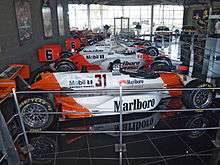
Opened in 2002, the Penske Racing Museum in Scottsdale, Arizona, is located within a complex of Penske Automotive Group car dealerships at the Scottsdale 101 Auto Collection. The two-story, 9,000-square-foot (840 m2) museum houses approximately 20 historically significant Penske Racing cars, along with trophies, artwork, engines and other memorabilia dating from Penske Racing's earliest origins up to the present day. Displays are rotated on a regular basis, but the museum focuses primarily on the team's successes in the Indy 500 and NASCAR, with lesser emphasis on F1 and sports car racing.
Racing results
Complete PPG CART Indycar World Series/CART FedEx Championship Series results
(key) (Results in bold indicate pole position; results in italics indicate fastest lap)
| Year | Chassis | Engine | Drivers | No. | 1 | 2 | 3 | 4 | 5 | 6 | 7 | 8 | 9 | 10 | 11 | 12 | 13 | 14 | 15 | 16 | 17 | 18 | 19 | 20 |
|---|---|---|---|---|---|---|---|---|---|---|---|---|---|---|---|---|---|---|---|---|---|---|---|---|
| 1979 | Cosworth DFX V8t | PHX | ATL | INDY | TRT | MCH | WGL | TRT | ONT | MCH | ATL | PHX | ||||||||||||
| Penske PC-7 Penske PC-6 |
|
9 | 2 | 5 | 2 | 1 | 5 | 7 | 4 | 5 | 2 | 1 | 2 | 3 | 1 | 3 | ||||||||
| Penske PC-7 | |
12 | 5 | 7 | 4 | 5 | 1 | 1 | 19 | 1 | 1 | 2 | 1 | 1 | 3 | 2 | ||||||||
| |
68 | DNQ | ||||||||||||||||||||||
| |
99 | 3 | DNQ | |||||||||||||||||||||
| 1980 | Cosworth DFX V8t | ONT | INDY | MIL | POC | MDO | MCH | WGL | MIL | ONT | MCH | MXC | PHX | |||||||||||
| Penske PC-7 Penske PC-9 |
|
1 | 21 | 5 | 5 | 12 | 9 | 4 | 2 | 2 | 3 | 3 | 1 | 7 | ||||||||||
| Penske PC-9 | |
11 | 23 | 19 | 1 | 1 | 15 | 2 | 1 | 3 | 1 | 2 | 2 | DNQ | ||||||||||
| |
12 | 20 | 17 | 1 | 2 | |||||||||||||||||||
| Penske PC-7 | |
61 | 6 | 5 | 9 | |||||||||||||||||||
| 1981 | Penske PC-9B | Cosworth DFX V8t | PHX | MIL | ATL | MCH | RIR | MIL | MCH | WGL | MXC | PHX | ||||||||||||
| |
3 | 2 | 21 | 13 | 6 | 16 | 9 | 3 | 7 | 17 | 15* | 2 | ||||||||||||
| |
6 | 4 | 1 | 1* | 3 | 1* | 2 | 1 | 1 | 1 | 8 | |||||||||||||
| |
7 | 8 | 8 | 4 | 3 | 11 | 4 | 5 | 17 | |||||||||||||||
| 1982 | Penske PC-10 | Cosworth DFX V8t | PHX | ATL | MIL | CLE | MCH | MIL | POC | RIV | ROA | MCH | PHX | |||||||||||
| |
1 | 1* | 1* | 3 | 4 | 15* | 12* | 1* | 1* | 5 | 25 | 2 | ||||||||||||
| |
4 | 3 | 18 | 5 | 10* | 14 | 5 | 2 | 10 | 25 | 22 | 4 | ||||||||||||
| 1983 | Penske PC-11 Penske PC-10B |
Cosworth DFX V8t | ATL | INDY | MIL | CLE | MCH | ROA | POC | RIV | MDO | MCH | CPL | LAG | PHX | |||||||||
| |
1 | 8* | 3 | 7 | 4 | 17 | 3 | 19 | 9 | 1* | 13 | 21 | 17 | |||||||||||
| 2 | 3 | |||||||||||||||||||||||
| |
7 | 2 | 2 | 2 | 1* | 2 | 3 | 11 | 11 | 4 | 5 | 4 | 11 | 4 | ||||||||||
| 1984 | Penske PC-12 March 84C |
Cosworth DFX V8t | LBH | PHX | INDY | MIL | POR | MEA | CLE | MCH | ROA | POC | MDO | SAN | MCH | PHX | LAG | CPL | ||||||
| |
1 | 22 | 21 | 5 | 27 | 8 | 10 | 30 | 3 | 8 | 8 | 13 | 4 | 17 | 6 | 14 | ||||||||
| 2 | 3 | |||||||||||||||||||||||
| |
6 | 21 | 18 | 1* | 2 | 10 | 10 | 4 | 3 | 4 | 2 | 5* | DNQ | |||||||||||
| March 84C | |
5 | 14* | 11 | ||||||||||||||||||||
| |
18 | 20 | ||||||||||||||||||||||
| 1985 | March 85C | Cosworth DFX V8t | LBH | INDY | MIL | POR | MEA | CLE | MCH | ROA | POC | MDO | SAN | MCH | LAG | PHX | MIA | |||||||
| |
4 | 3 | 4 | 27 | 18 | 27 | 14 | 13 | 5 | 2 | 5 | 8 | 8 | 4 | 1 | |||||||||
| 5 | 1 | |||||||||||||||||||||||
| |
1 | 21 | ||||||||||||||||||||||
| 5 | 3 | 30 | 1 | 2 | ||||||||||||||||||||
| |
5 | 4 | 3 | 3 | 7 | 27 | 13* | 2 | 1* | 4 | ||||||||||||||
| 11 | 4 | 2* | 3 | 12 | ||||||||||||||||||||
| 1986 | Penske PC-15 March 86C |
Chevrolet 265A V8t Cosworth DFX V8t |
PHX | LBH | INDY | MIL | POR | MEA | CLE | TOR | MCH | POC | MDO | SAN | MCH | ROA | LAG | PHX | MIA | |||||
| |
1 | 19 | 20 | 3 | 16 | 19 | 4 | 8 | 12 | 8 | 17 | 18 | 8 | 3 | 17 | 20 | 3 | |||||||
| 4 | 3* | |||||||||||||||||||||||
| |
4 | 11 | 11 | 11 | 1 | 1* | 2 | 25 | 16 | 3* | 5 | 12 | 6 | 2 | 2 | 26 | ||||||||
| 1 | 9 | |||||||||||||||||||||||
| Chevrolet 265A V8t | |
11 | 18 | 22 | 14 | 20 | 15 | |||||||||||||||||
| 1987 | Penske PC-16 March 86C |
Chevrolet 265A V8t | LBH | PHX | INDY | MIL | POR | MEA | CLE | TOR | MCH | POC | ROA | MDO | NAZ | LAG | MIA | |||||||
| |
3 | 22 | 11 | 13 | 11 | 11 | 20 | 4 | 2 | 4 | 17 | 5 | 3 | 22 | 2 | 12 | ||||||||
| |
8 | 9 | 20 | 23 | 21 | 3 | 18 | 7 | 10 | 21 | 1* | 9 | 4 | 3 | 3 | 5 | ||||||||
| |
25 | Inj | ||||||||||||||||||||||
| March 86C | Cosworth DFX V8t | |
1 | |||||||||||||||||||||
| 6 | 2 | 15 | ||||||||||||||||||||||
| Penske PC-16 | Chevrolet 265A V8t | 9 | DNQ | |||||||||||||||||||||
| 1988 | Penske PC-17 | Chevrolet 265A V8t | PHX | LBH | INDY | MIL | POR | CLE | TOR | MEA | MIC | POC | MDO | ROA | NAZ | LAG | MIA | |||||||
| 5 | 22 | 8 | 1 | 1 | 6 | 23 | 6 | 3 | 13 | 23 | 3 | 12 | 7 | 5 | 2 | |||||||||
| 9 | 23 | 13 | 23* | 2 | 1 | 3 | 2 | 4 | 1 | 18 | 5 | 4 | 1 | 1 | 5 | |||||||||
| |
1 | 3 | ||||||||||||||||||||||
| 60 | 9 | 13 | ||||||||||||||||||||||
| 1989 | Penske PC-18 | Chevrolet 265A V8t | PHX | LBH | INDY | MIL | DET | POR | CLE | MEA | TOR | MCH | POC | MDO | ROA | NAZ | LAG | |||||||
| 1 | 3 | 8 | 28 | 10 | 24 | 8 | 3* | 23 | 1 | 5 | 1 | 3 | 14 | |||||||||||
| 14 | ||||||||||||||||||||||||
| |
10 | |||||||||||||||||||||||
| 25 | 24 | 8 | 7 | |||||||||||||||||||||
| 4 | 1 | 5 | 23 | 1 | 5 | 8 | 5 | 4 | 5 | 7 | 2 | 6 | 3 | 2 | 1 | |||||||||
| 1990 | Penske PC-19 | Chevrolet 265A V8t | PHX | LBH | INDY | MIL | DET | POR | CLE | MEA | TOR | MCH | DEN | VAN | MDO | ROA | NAZ | LAG | ||||||
| |
1 | 5 | 2 | 3 | 3 | 7 | 9 | 3 | 6 | 20 | 17 | 18 | 6 | 12 | 2 | 1 | 6 | |||||||
| 2 | 1 | 6 | 5 | 2 | 4 | 5 | 8 | 2 | 12 | 14 | 7 | 4 | 7 | 3 | 2 | 4 | ||||||||
| 7 | 6 | 3 | 32 | 8 | 14 | 4 | 1 | 14 | 4 | 21 | 2 | 2 | 5 | 16 | 18 | 1 | ||||||||
| 1991 | Penske PC-20 | Chevrolet 265A V8t | SFR | LBH | PHX | INDY | MIL | DET | POR | CLE | MEA | TOR | MCH | DEN | VAN | MDO | ROA | NAZ | LAG | |||||
| 3 | 3 | 4 | 5 | 1 | 15 | 5 | 6 | 17 | 3 | 20 | 1 | 8 | 6 | 6 | 15 | 15 | 5 | |||||||
| |
5 | 19 | 17 | 3 | 11 | 8 | 1 | 2 | 2 | 7 | 21 | 20 | 2 | 17 | 2 | 6 | 8 | 4 | ||||||
| Penske PC-19 | |
17 | 21 | 7 | 25 | |||||||||||||||||||
| 1992 | Penske PC-21 | Chevrolet 265B V8t | SFR | PHX | LBH | INDY | DET | POR | MIL | NHA | TOR | MCH | CLE | ROA | VAN | MDO | NAZ | LAG | ||||||
| |
5 | 1 | 3 | 3 | 24 | 8 | 2 | 4 | 21 | 19 | 13 | 1* | 1* | 19 | 1 | 7 | 19 | |||||||
| |
4 | 12 | ||||||||||||||||||||||
| 2 | 8 | 6 | 26 | 7 | 16 | 4 | 16 | |||||||||||||||||
| Penske PC-21 Penske PC-20 |
Chevrolet 265B V8t Chevrolet 265A V8t |
|
16 | 21 | 19 | 17 | 23 | 16 | ||||||||||||||||
| 7 | 4 | 20 | 2 | 2 | 3 | |||||||||||||||||||
| 1993 | Penske PC-22 | Chevrolet 265C V8t | SFR | PHX | LBH | INDY | MIL | DET | POR | CLE | TOR | MCH | NHA | ROA | VAN | MDO | NAZ | LAG | ||||||
| |
4 | 2 | 14 | 13 | 1 | 3 | 23 | 1 | 2 | 2 | 13 | 3 | 5 | 7 | 1 | 5 | 2 | |||||||
| |
12 | 21 | 16 | 1 | 30 | 20 | 9 | 3 | 1 | 1 | 19 | 2 | 1 | 13 | 25 | 3 | 1 | |||||||
| 1994 | Penske PC-23 | Ilmor 265D V8t Mercedes-Benz 500I V8t |
SFR | PHX | LBH | INDY | MIL | DET | POR | CLE | TOR | MCH | MDO | NHA | VAN | ROA | NAZ | LAG | ||||||
| |
2 | 2 | 1* | 21 | 17* | 2 | 2 | 2 | 20 | 3 | 10 | 3 | 3* | 9 | 3 | 3 | 4 | |||||||
| |
3 | 16 | 23 | 20 | 23 | 3 | 1 | 3 | 3 | 5 | 16 | 2* | 2 | 20 | 18* | 1* | 1* | |||||||
| |
31 | 14 | 2 | 1* | 1 | 1* | 10* | 1* | 1* | 29 | 8 | 1 | 1 | 1 | 2 | 2 | 20 | |||||||
| 1995 | Penske PC-24 | Mercedes-Benz IC108B V8t | MIA | SFR | PHX | LBH | NAZ | INDY | MIL | DET | POR | ROA | TOR | CLE | MCH | MDO | NHA | VAN | LAG | |||||
| |
1 | 15 | 6 | 8 | 1* | 13 | DNQ | 2* | 5 | 1* | 28 | 26 | 18 | 2 | 1 | 3 | 1* | 6 | ||||||
| Lola T95/00 | 11 | DNQ | ||||||||||||||||||||||
| Reynard 94i | 21 | DNQ | ||||||||||||||||||||||
| Penske PC-24 | |
2 | 24 | 18 | 3* | 20 | 1 | DNQ | 23 | 10 | 21 | 15 | 10 | 25 | 5 | 21 | 5 | 7 | 16 | |||||
| Lola T95/00 | 9 | DNQ | ||||||||||||||||||||||
| Penske PC-23 | 89 | DNQ | ||||||||||||||||||||||
| 1996 | Penske PC-25 | Mercedes-Benz IC108C V8t | MIA | RIO | SFR | LBH | NAZ | 500 | MIL | DET | POR | CLE | TOR | MCH | MDO | ROA | VAN | LAG | ||||||
| |
2 | 8 | 2 | 9 | 3 | 3 | 8 | 2* | 22 | 4 | 4 | 13 | 4 | 13 | 10* | 5 | 16 | |||||||
| |
3 | 23* | 19 | 22 | 4 | 5 | 7 | 3 | 17 | 27 | 9 | 5 | DNS | 12 | 18 | 29 | ||||||||
| |
14 | |||||||||||||||||||||||
| 1997 | Penske PC-26 | Mercedes-Benz IC108D V8t | MIA | SFR | LBH | NAZ | RIO | GAT | MIL | DET | POR | CLE | TOR | MCH | MDO | ROA | VAN | LAG | FON | |||||
| |
2 | 27 | 27 | 4 | 3 | 7 | 18 | 20 | 8 | 25 | 4 | 20 | 20 | 22 | 7 | 5 | 11 | 22 | ||||||
| |
3 | 2 | 19* | 7 | 1* | 1 | 1 | 6 | Wth | 7 | 7 | 10 | 4 | 27 | 28 | 28 | 26 | 26 | ||||||
| 1998 | Penske PC-27 | Mercedes-Benz IC108E V8t | MIA | MOT | LBH | NAZ | RIO | GAT | MIL | DET | POR | CLE | TOR | MCH | MDO | ROA | VAN | LAG | HOU | SFR | FON | |||
| |
2 | 22 | 2 | 29 | 15 | 16 | 19 | 3 | 24 | 5 | 17 | 17 | 22 | 6 | 27 | 5 | 6 | 7 | 22 | 27 | ||||
| |
3 | 17 | 9 | 22 | DNS | 22 | 20 | 18 | 16 | 15 | 22 | 23 | 28 | 10 | 25 | 7 | 14 | 17 | 13 | 28 | ||||
| 1999 | Penske PC-27B Lola B99/00 |
Mercedes-Benz IC108E V8t | MIA | MOT | LBH | NAZ | RIO | GAT | MIL | POR | CLE | ROA | TOR | MCH | DET | MDO | CHI | VAN | LAG | HOU | SRF | FON | ||
| |
2 | 26 | 24 | 12 | 12 | 19 | 16 | 5 | 9 | 9 | 13 | 15 | 25 | 25 | 25 | Wth | 15 | 22 | 7 | |||||
| |
14 | 25 | ||||||||||||||||||||||
| 3 | 9 | 26 | 18 | 24 | ||||||||||||||||||||
| Penske PC-27B | |
18 | 24 | |||||||||||||||||||||
| Lola B99/00 | |
12 | DNS | |||||||||||||||||||||
| 2000 | Reynard 2Ki | Honda HR-0 V8t | MIA | LBH | RIO | MOT | NAZ | MIL | DET | POR | CLE | TOR | MCH | CHI | MDO | ROA | VAN | LAG | GAT | HOU | SRF | FON | ||
| |
2 | 6* | 7* | 17 | 9 | 1 | 12 | 9 | 1 | 14 | 6 | 18 | 3 | 2 | 25 | 5 | 2 | 8 | 3* | 23 | 3 | |||
| |
3 | 25 | 2 | 24 | 13 | 16 | 16 | 1 | 7* | 21 | 16 | 5* | 21 | 1* | 9 | 20 | 1* | 9 | 5 | 6 | 9 | |||
| 2001 | Reynard 01i | Honda HR-1 V8t | MTY | LBH | NAZ | MOT | MIL | DET | POR | CLE | TOR | MCH | CHI | MDO | ROA | VAN | LAU | ROC | HOU | LAG | SRF | FON | ||
| |
1 | 2 | 3 | 23 | 13 | 7 | 6 | 13 | 4 | 14* | 24 | 3 | 2 | 5 | 2 | 8 | 1* | 1* | 3* | 4 | 6 | |||
| |
3 | 8 | 1* | 11 | 2* | 26 | 1* | 17 | 12 | 19 | 8 | 7* | 1* | 7* | 18 | 12 | 4 | 5 | 6 | 20 | 22 | |||
Complete IRL IndyCar Series results
(key)
| Year | Chassis | Engine | Drivers | No. | 1 | 2 | 3 | 4 | 5 | 6 | 7 | 8 | 9 | 10 | 11 | 12 | 13 | 14 | 15 | 16 | 17 | 18 | 19 |
|---|---|---|---|---|---|---|---|---|---|---|---|---|---|---|---|---|---|---|---|---|---|---|---|
| 2001 | Dallara IR-01 | Oldsmobile Aurora V8 | PHX | HMS | ATL | INDY | TXS | PPIR | RIR | KAN | NSH | KTY | GAT | CHI | TXS | ||||||||
| |
66 | 24 | 2 | ||||||||||||||||||||
| |
68 | 18 | 1* | ||||||||||||||||||||
| 2002 | Dallara IR-02 | Chevrolet Indy V8 | HMS | PHX | FON | NAZ | INDY | TXS | PPIR | RIR | KAN | NSH | MCH | KTY | GAT | CHI | TXS | ||||||
| |
3 | 3 | 1 | 5 | 5 | 1 | 4 | 2 | 17 | 3 | 9 | 6 | 5 | 2* | 4 | 2* | |||||||
| |
6 | 2 | 2 | 4 | 3* | 10 | 16 | 1* | 2* | 5 | 2 | 5 | 21 | 1 | 23 | ||||||||
| |
21 | ||||||||||||||||||||||
| 2003 | Dallara IR-03 G-Force GF09 |
Toyota Indy V8 | HMS | PHX | MOT | INDY | TXS | PPIR | RIR | KAN | NSH | MCH | GAT | KTY | NAZ | CHI | FON | TXS | |||||
| |
3 | 3 | 2 | 22 | 2 | 7 | 12 | 2 | 2 | 3 | 17 | 1* | 5 | 1* | 20 | 6 | 13 | ||||||
| |
6 | 2* | 14 | 1 | 8 | 3 | 3 | 3* | 1 | 7 | 3 | 9 | 4 | 12 | 15 | 1* | |||||||
| |
17 | ||||||||||||||||||||||
| 2004 | Dallara IR-04 | Toyota Indy V8 | HMS | PHX | MOT | INDY | TXS | RIR | KAN | NSH | MIL | MCH | KTY | PPIR | NAZ | CHI | FON | TXS | |||||
| |
3 | 2* | 6 | 3 | 9 | 12 | 3 | 7 | 3 | 12 | 10 | 12 | 6 | 5* | 10 | 7* | 1* | ||||||
| |
6 | 1 | 15 | 19 | 26 | 4 | 11 | 8 | 2 | 3 | 4 | 14 | 18 | 11 | 6 | 4 | 17 | ||||||
| 2005 | Dallara IR-05 | Toyota Indy V8 | HMS | PHX | STP | MOT | INDY | TXS | RIR | KAN | NSH | MIL | MCH | KTY | PPIR | SNM | CHI | WGL | FON | ||||
| |
3 | 5 | 2 | 20 | 11 | 9 | 5 | 1* | 8 | 5 | 16 | 21 | 5 | 4 | 21 | 2 | 12 | 9 | |||||
| |
6 | 2 | 1 | 15 | 7 | 23* | 2 | 18 | 12 | 2 | 1* | 5 | 7 | 2* | 17 | 3 | 7 | 5 | |||||
| 2006 | Dallara IR-05 | Honda HI6R V8 | HMS | STP | MOT | INDY | WGL | TXS | RIR | KAN | NSH | MIL | MCH | KTY | SNM | CHI | |||||||
| |
3 | 2 | 1* | 1* | 25 | 7 | 1 | 10 | 6 | 5 | 14 | 1 | 3 | 5 | 4 | ||||||||
| |
6 | 3* | 8 | 4 | 1 | 12 | 4 | 1* | 1* | 14 | 2 | 19 | 1 | 9 | 3 | ||||||||
| 2007 | Dallara IR-05 | Honda HI7R V8 | HMS | STP | MOT | KAN | INDY | MIL | TXS | IOW | RIR | WGL | NSH | MDO | MCH | KTY | SNM | DET | CHI | ||||
| |
3 | 9 | 1* | 7 | 3 | 3 | 16* | 16 | 8 | 11 | 18 | 6 | 3* | 17 | 9 | 2 | 14 | 4 | |||||
| |
6 | 3 | 7 | 5 | 6 | 4 | 9 | 1* | 14 | 15 | 2 | 4 | 14 | 9 | 18 | 5 | 12 | 3* | |||||
| 2008 | Dallara IR-05 | Honda HI7R V8 | HMS | STP | MOT | LBH | KAN | INDY | MIL | TXS | IOW | RIR | WGL | NSH | MDO | EDM | KTY | SNM | DET | CHI | SRF | ||
| |
3 | 4 | 2 | 2 | 4 | 4 | 5 | 2* | 14* | 2 | 16 | 3 | 2 | 2* | 2 | 1* | 2 | 1* | 7 | ||||
| |
6 | 19 | 23 | 9 | 7 | 23 | 1 | 3 | 7 | 15 | 12* | 23 | 1* | 6 | 7 | 2 | 9 | 3 | 1 | ||||
| 2009 | Dallara IR-05 | Honda HI7R V8 | STP | LBH | KAN | INDY | MIL | TXS | IOW | RIR | WGL | TOR | EDM | KTY | MDO | SNM | CHI | MOT | HMS | ||||
| |
3 | 7 | 2 | 1 | 11 | 1 | 7 | 17 | 4 | 18 | 2 | 4 | 12 | 18 | 20 | 10 | 5 | ||||||
| |
6 | ||||||||||||||||||||||
| 12 | 2 | 5 | 3 | 1* | 9 | DNS | |||||||||||||||||
| |
6 | 1 | 13 | 4 | 15 | 2* | 2* | 2* | 19 | 2 | 2 | 4 | 1 | 2 | 2 | 1* | 18 | 2* | |||||
| 2010 | Dallara IR-05 | Honda HI7R V8 | SAO | STP | ALA | LBH | KAN | INDY | TXS | IOW | WGL | TOR | EDM | MDO | SNM | CHI | KTY | MOT | HMS | ||||
| |
3 | 9 | 4 | 1 | 7 | 4 | 9 | 20 | 2 | 9 | 24 | 10 | 3 | 5 | 6 | 1 | 1* | 5 | |||||
| |
6 | 14 | 3 | 6 | 8 | 6 | 24 | 1* | 4 | 2 | 18 | 4 | 6 | 4 | 11* | 24 | 4 | 4 | |||||
| |
12 | 1 | 1* | 4 | 3 | 12 | 8 | 14 | 5 | 1* | 1 | 2* | 2 | 1* | 16 | 8 | 3 | 25 | |||||
| 2011 | Dallara IR-05 | Honda HI7R V8 | STP | ALA | LBH | SAO | INDY | TXS | MIL | IOW | TOR | EDM | MDO | NHA | SNM | BAL | MOT | KTY | LSV | ||||
| |
3 | 20 | 7 | 12 | 21 | 17 | 10 | 4 | 9 | 7 | 17 | 2 | 19 | 17 | 2 | 17 | 22 | 29 | C1 | ||||
| |
6 | 18 | 21 | 2* | 3 | 27 | 6 | 3 | 11 | 6 | 7 | 10 | 16 | 8 | 3 | 14 | 20 | 8 | C1 | ||||
| |
12 | 2 | 1* | 10 | 1* | 14 | 3 | 1* | 4 | 21 | 24* | 1* | 14 | 5 | 1* | 1* | 2 | 19 | C1 | ||||
| 2012 | Dallara DW12 | Chevrolet IndyCar V6t | STP | ALA | LBH | SAO | INDY | DET | TXS | MIL | IOW | TOR | EDM | MDO | SNM | BAL | FON | ||||||
| |
2 | 5 | 14 | 7 | 25 | 5 | 16 | 3 | 14 | 18 | 19 | 8 | 7 | 1 | 2 | 17 | |||||||
| |
3 | 1 | 3 | 13 | 4 | 10 | 17 | 7 | 6 | 6* | 6 | 1 | 16 | 6 | 10 | 5 | |||||||
| |
12 | 7 | 1 | 1 | 1* | 28 | 4 | 8 | 12 | 23 | 15 | 3 | 2* | 2* | 6* | 24 | |||||||
| 2013 | Dallara DW12 | Chevrolet IndyCar V6t | STP | ALA | LBH | SAO | INDY | DET | TXS | MIL | IOW | POC | TOR | MDO | SNM | BAL | HOU | FON | |||||
| |
2 | 19 | 23 | 7 | 25 | 25 | 16 | ||||||||||||||||
| |
3 | 2 | 3 | 10 | 13 | 6 | 5 | 8 | 1* | 2 | 8 | 8 | 6 | 2 | 6 | 7 | 9 | 18 | 23 | 6 | |||
| |
12 | 16 | 5 | 16 | 24 | 19 | 8 | 20 | 7 | 3 | 17 | 4 | 15* | 18 | 4 | 1 | 18* | 12 | 1* | 1* | |||
| 2014 | Dallara DW12 | Chevrolet IndyCar V6t | STP | LBH | ALA | IMS | INDY | DET | TXS | HOU | POC | IOW | TOR | MDO | MIL | SNM | FON | ||||||
| |
2 | 15 | 4 | 21 | 16 | 5 | 12 | 13 | 3 | 2 | 7 | 1 | 16 | 18 | 19 | 11 | 2 | 5 | 4* | ||||
| |
3 | 3 | 11 | 19 | 3 | 2 | 5* | 1* | 8 | 9 | 21* | 2 | 8 | 2 | 12* | 19 | 11 | 18 | 14 | ||||
| |
12 | 1* | 2 | 5 | 8 | 8 | 1 | 2 | 2* | 14 | 11 | 10 | 14 | 10 | 3 | 6 | 1* | 10* | 9 | ||||
| 2015 | Dallara DW12 | Chevrolet IndyCar V6t | STP | NOL | LBH | ALA | IMS | INDY | DET | TXS | TOR | FON | MIL | IOW | MDO | POC | SNM | ||||||
| |
1 | 2* | 7 | 20 | 4 | 1* | 2 | 4 | 18 | 13 | 4* | 19* | 22 | 10 | 14 | 4 | 7 | ||||||
| |
2 | 1 | 5* | 3 | 14 | 3 | 1 | 10 | 10* | 4 | 7 | 4 | 4 | 24 | 11 | 3 | 6 | ||||||
| |
3 | 4 | 2 | 2 | 15 | 6 | 7 | 6 | 19 | 3 | 3 | 23 | 2 | 11 | 15 | 16 | 15 | ||||||
| |
22 | 5 | 20 | 4 | 9 | 25 | 10 | 3 | 14 | 11 | 11 | 9 | 9 | 14 | 3 | 7 | 16 | ||||||
| 2016 | Dallara DW12 | Chevrolet IndyCar V6t | STP | PHX | LBH | ALA | IMS | INDY | DET | ROA | IOW | TOR | MDO | POC | TXS | WGL | SNM | ||||||
| |
2 | 1 | 9 | 4 | 5 | 8 | 33 | 3 | 20 | 7 | 20 | 20 | 11 | 8 | 9 | 13 | 3 | ||||||
| |
3 | 4 | 11 | 3* | 7 | 2 | 11 | 5 | 14 | 5 | 13 | 2 | 15 | 19 | 5 | 3 | 7 | ||||||
| |
12 | DNS | 3 | 7 | 4 | 19 | 10 | 20 | 1 | 1* | 2 | 1 | 2 | 1 | 8 | 20 | 20 | ||||||
| 18 | |||||||||||||||||||||||
| |
22 | 2* | 2 | 1 | 1* | 1* | 19 | 13* | 2* | 13 | 4 | 9 | 1 | 18 | 4 | 7 | 1* | ||||||
Complete Formula One World Championship results
(italics indicates non-works entries; bold indicates championships won)
| Formula One results | |||||||||||||||||||||||
|---|---|---|---|---|---|---|---|---|---|---|---|---|---|---|---|---|---|---|---|---|---|---|---|
| Year | Name | Car | Engine | Tyres | No. | Drivers | Points | WCC | |||||||||||||||
| 1971 | Penske-White Racing | McLaren M19A | Ford Cosworth DFV 3.0 V8 | G | |
N/A | |||||||||||||||||
| 1972 – 1973: Team Penske did not compete. | |||||||||||||||||||||||
| 1974 | Penske Cars | Penske PC1 | Ford Cosworth DFV 3.0 V8 | G | 66 | |
0 | - | |||||||||||||||
| 1975 | Penske Cars | Penske PC1 March 751 |
Ford Cosworth DFV 3.0 V8 | G | 28 | |
2 | 12th | |||||||||||||||
| 1976 | Citibank Team Penske | Penske PC3 Penske PC4 |
Ford Cosworth DFV 3.0 V8 | G | 28 | |
20 | 5th | |||||||||||||||
| F&S Properties | Penske PC3 | 39 | | ||||||||||||||||||||
| 1977 | ATS Racing Team | Penske PC4 | Ford Cosworth DFV 3.0 V8 | G | 33 / 35 34 35 |
|
1 | 12th | |||||||||||||||
| Interscope Racing | 14 | | |||||||||||||||||||||
Team Championship and Major Wins
IndyCar champions
| Year | Champion | Wins | Chassis | Engine | Tyres |
|---|---|---|---|---|---|
| 1977 | |
2 | McLaren M24 Penske PC-5 |
Cosworth | Goodyear |
| 1978 | |
0 | Penske PC-6 | Cosworth | Goodyear |
| 1979 | |
3 | Penske PC-7 Penske PC-6 |
Cosworth | Goodyear |
| 1981 | |
6 | Penske PC-9B | Cosworth | Goodyear |
| 1982 | |
4 | Penske PC-10 | Cosworth | Goodyear |
| 1983 | |
1 | Penske PC-11 | Cosworth | Goodyear |
| 1985 | |
1 | March 85C | Cosworth | Goodyear |
| 1988 | |
4 | Penske PC-17 | Chevrolet A | Goodyear |
| 1994 | |
8 | Penske PC-23 | Ilmor, Mercedes-Benz | Goodyear |
| 2000 | |
2 | Reynard 2KI | Honda HR-0 | Firestone |
| 2001 | |
2 | Reynard 01i | Honda HR-1 | Firestone |
| 2006 | |
4 | Dallara IR-05 | Honda HI6R | Firestone |
| 2014 | |
3 | Dallara DW12 | Chevrolet IndyCar V6t | Firestone |
| 2016 | |
5 | Dallara DW12 | Chevrolet IndyCar V6t | Firestone |
Indianapolis 500 victories
| Year | Champion | Chassis | Engine | Tyres |
|---|---|---|---|---|
| 1972 | |
McLaren M16B | Offenhauser | Goodyear |
| 1979 | |
Penske PC-6 | Cosworth | Goodyear |
| 1981 | |
Penske PC-9B | Cosworth | Goodyear |
| 1984 | |
March 84C | Cosworth | Goodyear |
| 1985 | |
March 85C | Cosworth | Goodyear |
| 1987 | |
March 86C | Cosworth | Goodyear |
| 1988 | |
Penske PC-17 | Chevrolet A | Goodyear |
| 1991 | |
Penske PC-20 | Chevrolet A | Goodyear |
| 1993 | |
Penske PC-22 | Chevrolet C | Goodyear |
| 1994 | |
Penske PC-23 | Mercedes-Benz 500I | Goodyear |
| 2001 | |
Dallara IR-01 | Oldsmobile Aurora V8 | Firestone |
| 2002 | |
Dallara IR-02 | Chevrolet Indy V8 | Firestone |
| 2003 | |
G-Force GF09 | Toyota Indy V8 | Firestone |
| 2006 | |
Dallara IR-05 | Honda HI6R | Firestone |
| 2009 | |
Dallara IR-05 | Honda HI9R | Firestone |
| 2015 | |
Dallara DW12 | Chevrolet IndyCar V6t | Firestone |
NASCAR Sprint Cup Series Champions
| Year | Champion | Wins | Chassis | Engine | Tyres |
|---|---|---|---|---|---|
| 2012 | |
5 | Dodge Charger | Dodge | Goodyear |
NASCAR Xfinity Series Champions
| Year | Champion | Wins | Chassis | Engine | Tyres |
|---|---|---|---|---|---|
| 2010 | |
6 | Dodge Charger/Challenger | Dodge | Goodyear |
Daytona 500 victories
| Year | Champion | Chassis | Engine | Tyres |
|---|---|---|---|---|
| 2008 | |
Dodge Charger | Dodge | Goodyear |
| 2015 | |
Ford Fusion | Ford | Goodyear |
Notes
- ↑ Team Penske - Year by Year Highlights, www.teampenske.com Retrieved 8 January 2015
- ↑ "Motorsports Hall of Fame of America and Museum:Roger Penske". Mshf.com. December 15, 2011. Retrieved August 13, 2012.
- ↑ "Constructors: Penske Racing". Grandprix.com. March 10, 2007. Retrieved August 13, 2012.
- ↑ Cavin, Curt. "Motor Sports | Indianapolis Star". indystar.com. Retrieved August 13, 2012.
- ↑ "Chevy, Penske explain new partnership". Racer.com. November 12, 2010. Retrieved August 13, 2012.
- ↑ "Will Power wins his first IndyCar championship". USA TODAY. Retrieved 2016-11-14.
- ↑ Martin, Bruce. "IndyCar: Team Penske coming to terms with championship loss". FOX Sports. Retrieved 2016-11-14.
- ↑ "Simon Pagenaud, Chevrolet win finale, Verizon IndyCar Series Championship for Team Penske". Autoweek. Retrieved 2016-11-14.
- ↑ "Bill's Driving 'em Bananas". CNN. July 22, 1985.
- ↑ Joe Menzer, NASCAR.COM (August 7, 2012). "Dodge pulling out of NASCAR at season's end – Aug 7, 2012". Nascar.Com. Retrieved August 13, 2012.
- ↑ Owens, Jeff (January 9, 2014). "Penske changes name of team to Team Penske". Sporting News. Retrieved January 9, 2014.
- ↑ Penske Racing South (July 19, 2000). "ALLTEL Corporation Teams Up With Penske Racing South: Ryan Newman to Run Selected ARCA Events". PR Newswire. Mooresville, North Carolina. Retrieved 7 February 2016.
- ↑ Radebaugh (October 14, 2000). "Ryan Newman dominates at Charlotte". Concord, North Carolina: motorsport.com. Retrieved 7 February 2016.
- ↑ Rodman, Dave (October 10, 2000). "Penske buys Kranefuss' share". Mooresville, North Carolina: motorsport.com. Retrieved 7 February 2016.
- ↑ Siano, Joseph (January 2, 1994). "AUTO RACING; Hey, Rusty Wallace and Roger Penske, Have You Driven a Ford Lately?". The New York Times.
- ↑ "Talladega Qualifying and Starting Lineup". Jayski's Silly Season Site. Retrieved December 7, 2013.
- ↑ Ryan, Nate (April 30, 2014). "Juan Pablo Montoya returning to NASCAR at Indy, Michigan". USA Today. Retrieved April 30, 2014.
- ↑ "Penske Racing, Kurt Busch Mutually Agree to Separation". Penske Racing. Retrieved December 5, 2011.
- ↑ "Allmendinger to Drive Shell-Pennzoil Dodge in 2012". Penske Racing. Retrieved December 21, 2011.
- ↑ Gelston, Dan. "NASCAR: Penske dumps Allmendinger after drug test » Sports » Goshen News, Goshen, IN". Goshennews.com. Retrieved August 13, 2012.
- ↑ Newton, David (September 6, 2012). "Joey Logano joins Penske Racing". ESPN.com. ESPN Inc. Retrieved May 23, 2015.
- ↑ Gluck, Jeff (July 31, 2013). "Why will Joey Logano drive No. 48 car at Watkins Glen?". USA Today. USA Today. Retrieved December 20, 2014.
- ↑ "Blaney Driving The No. 48 AutoZone Ford In Nationwide Series". ryanblaney.com. ryanblaney.com. November 6, 2013. Retrieved December 20, 2014.
- 1 2 Spencer, Reid (November 16, 2013). "AUSTIN DILLON CLAIMS TITLE; KESELOWSKI TAKES WIN". nascar.com. Homestead, Florida: NASCAR. Retrieved December 20, 2014.
- ↑ "Wheels & Deals: Verizon To Sponsor Penske Nationwide Entry". Sports Business Daily. Archived from the original on February 3, 2009. Retrieved March 6, 2016.
- ↑ Long, Mark (November 17, 2013). "Roger Penske says maybe he started Sam Hornish Jr.'s career going 'backwards'". Autoweek. Retrieved November 19, 2013.
- ↑ Broomberg, Nick (January 22, 2014). "Additions of Wurth and Alliance round out 2014 sponsorship for Brad Keselowski". Yahoo! Sports. Yahoo!. Retrieved September 20, 2014.
- ↑ Moody, Dave (July 17, 2012). "Blaney Replaces Kligerman in Penske Nationwide Entry". godfathermotorsports.com. godfathermotorsports.com. Retrieved September 20, 2014.
- ↑ Penske Racing (May 17, 2012). "Penske Racing names Villeneuve for Road America and Montreal events". motorsport.com. Mooresville, North Carolina: motorsport.com. Retrieved September 20, 2014.
- ↑ Penske Racing (June 1, 2013). "AJ Allmendinger to race in NNS events at Road America and Mid-Ohio for Penske Racing". motorsport.com. Mooresville, North Carolina: motorsport.com. Retrieved September 20, 2014.
- ↑ Staff Report (June 22, 2013). "ALLMENDINGER WINS COORS LIGHT POLE AT ROAD AMERICA". NASCAR.com. Elkhart Lake, Wisconsin: NASCAR. Retrieved September 20, 2014.
- ↑ Staff Report (June 22, 2013). "ALLMENDINGER WINS AT ROAD AMERICA". NASCAR.com. Elkhart Lake, Wisconsin: NASCAR. Retrieved September 20, 2014.
- ↑ Vincent, Amanda (August 18, 2013). "Allmendinger dominates Mid-Ohio to earn the victory". motorsport.com. motorsport.com. Retrieved September 20, 2014.
- ↑ Vincent, Amanda (September 22, 2013). "Ryan Blaney scores his first NNS win at Kentucky". motorsport.com. motorsport.com. Retrieved September 20, 2014.
- ↑ NASCAR Wire Service (September 18, 2014). "Familiar faces Hornish and McDowell return to action with owner points title implications". motorsport.com. motorsport.com. Retrieved September 20, 2014.
- ↑ Penske Racing (July 3, 2010). "Daytona II: Parker Kligerman race report". motorsport.com. Daytona Beach, Florida: motorsport.com. Retrieved September 19, 2014.
- ↑ Dodge Motorsports (October 17, 2010). "Charlotte II: Dodge teams race quotes". motorsport.com. motorsport.com. Retrieved September 19, 2014.
- ↑ javelinamx.com Archived July 6, 2006, at the Wayback Machine.
- ↑ "1974 United States Grand Prix Entry list".
- ↑ "DJR Penske clarifies ownership, key staff". Speedcafe. September 15, 2014.
- ↑ "Penske confirms 2015 V8 Supercar entry". Speedcafe. September 15, 2014.
- ↑ "Ambrose to take a back seat in Tasmania". V8 Supercars. March 17, 2015. Retrieved March 17, 2015.
- ↑ "Fabian Coulthard signs with DJR Team Penske in expanded two-car lineup for 2016 V8 Supercars season". October 13, 2015. Retrieved October 26, 2015.
- ↑ Bartholomaeus, Stefan (November 8, 2015). "Ambrose elects against enduro return for 2016". Speedcafe. Retrieved November 8, 2015.
External links
| Wikimedia Commons has media related to Penske Racing. |